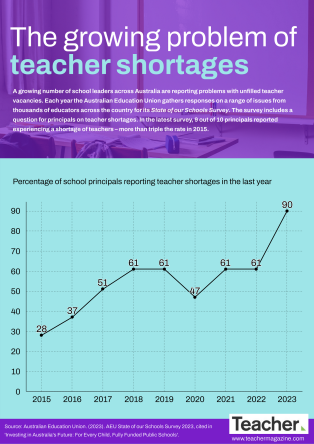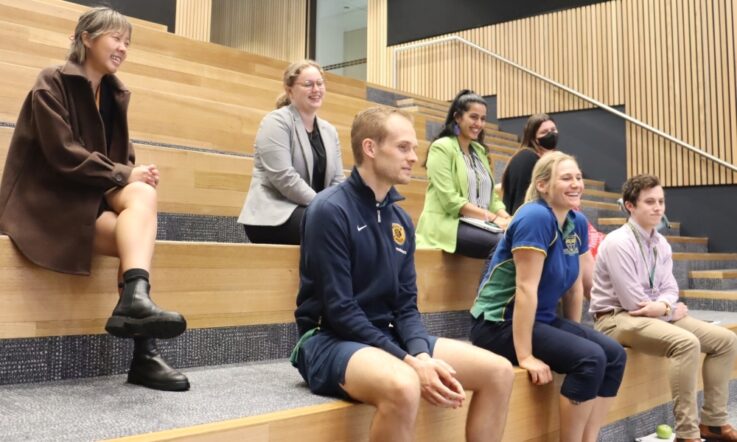Educator voices are central to developing a better understanding of the challenges schools face, and any potential solutions. An Australian study looks at teacher readiness, attributes and qualities from the perspective of principals.
Researchers from La Trobe University interviewed 17 principals to explore the issue through the lens of leaders in hard-to-staff schools. Dr Babak Dadvand is a Senior Lecturer in pedagogy, professional practice, and teacher education at La Trobe and lead researcher of this study.
‘We wanted to look at this from the perspective of school leaders because they are crucial in making hiring and staffing decisions,’ he tells Teacher. ‘They are in a position between the school and the community, which allows them to understand the specific needs and strengths of their schools and communities.
‘Engaging with school leaders ensures that teacher readiness discussions are grounded in the realities of schools.’
The academic and colleagues Juliana Ryan, Miriam Tanti, Steve Murphy, Bronwyn Murphy and Kerri Flanigan have just published a research report sharing findings from the small-scale study and recommendations (Dadvand et al., 2024).
Teacher readiness – 4 key themes
From the principal interviews, 4 key themes emerged in relation to readiness and the core attributes and qualities needed to teach in their schools.
Knowing the community: Whilst school leaders said content knowledge was crucial, they highlighted the importance of building strong relationships with students, and the ability to understand and connect with the local community. One regional school principal commented:
The reality is that when you get into a school and you’ve got 20 or so students to manage, that curriculum knowledge is so secondary to the skills that have to be in place so that the children have someone who supports them, someone who co-regulates them, makes them feel safe, and if you’ve got this in place then you can meet them at their point of need.
Care and responsibility: Several principals said nurturing a learning environment that fosters a sense of belonging in students, contributing to a culture of care at the school, and understanding student needs was essential.
We’ve got kids who’ve experienced trauma and all sorts of things that you couldn’t begin to imagine, and then we try and get them into a classroom, and do their reading, writing and mathematics. I guess it’s knowing Maslow’s hierarchy of need. They’re just wanting a safe space …
Adaptability and willingness to learn: In relation to this theme, the researchers cite a phenomenon called ‘praxis shock’, where graduates enter the classroom and have their existing beliefs about life as a teacher challenged. When thinking about the some of the graduate teachers in his own school, ‘One principal likened this experience to that of a “deer caught in the headlights,”’ the report highlights. Preservice teachers needed to be flexible and able to adapt their own approach in the classroom based on specific needs of students in their context.
A willingness to continue their professional learning journey was also highlighted:
You’ve got to come in with confidence and humility and the ability to say “I’m at the start of my journey, and I’m looking forward to being mentored in your school. I want to grow in your school”.
Teamwork and collaboration: Effective communication, collaboration and strong collegial relationships were also singled out as critical.
You have to be able to demonstrate that you not only are able to communicate with children, but also adults. You’ve got to be able to work in a team, work at a school which is dynamic, and you’ve got to be able to talk to parents.
The importance of school context
Reflecting on the study findings, Dr Dadvand says the key takeaway for teachers – especially preservice or those still early in their career – is the recognition that schools are ‘complex and diverse ecosystems’.
‘Schools often serve communities that have unique strengths but also face specific challenges, such as geographic isolation or historic disadvantages,’ he tells Teacher. ‘We were surprised by the extent to which leaders emphasised the importance of contextual factors in determining teacher readiness.’
Recommendations
In their report, the researchers say it’s difficult to make broad generalisations, given the small number of schools involved in the study, but the findings offer pointers for better preparation of new teachers.
These include community-centred professional placements (such as a local literacy program where preservice teachers could learn more about the diverse needs of students), and involvement in community-based, education-related projects (giving additional experience of lesson planning and community contexts.
Closer collaboration between university- and school-based mentors is another suggestion. The report shares an example of a ‘hybrid model’ where mentor teachers from schools are co-employed by the university faculty.
And greater leveraging of ICT in the mentoring process is recommended – for example, using online mentoring to overcome geographical challenges, and technology as a university-school collaboration tool, particularly for those in remote locations.
References
Dadvand, B., Ryan, J., Tanti, M., Murphy, S., Murphy, B., & Flanigan. K. (2024). Community-centric approaches to teacher preparation for hard-to-staff schools. La Trobe University. http://nla.gov.au/nla.obj-3346927412



